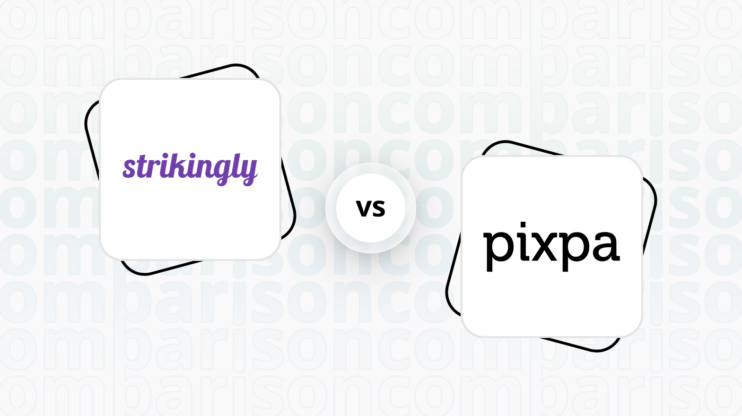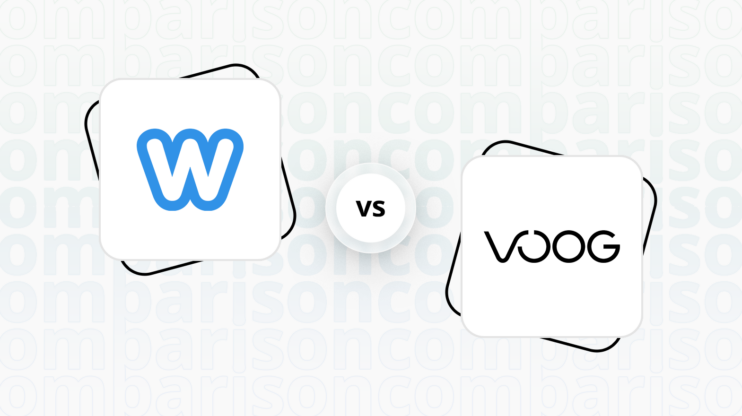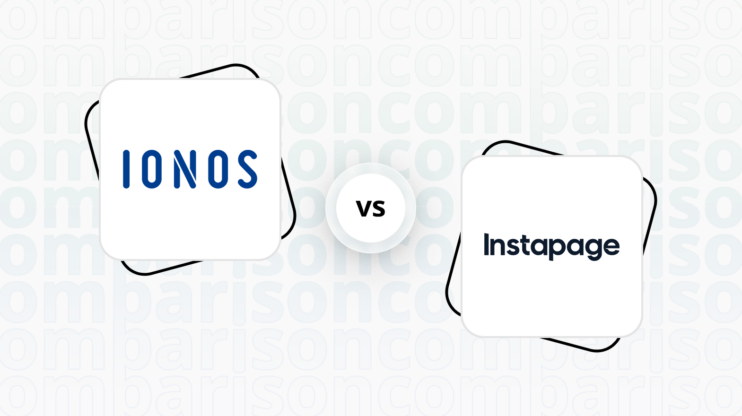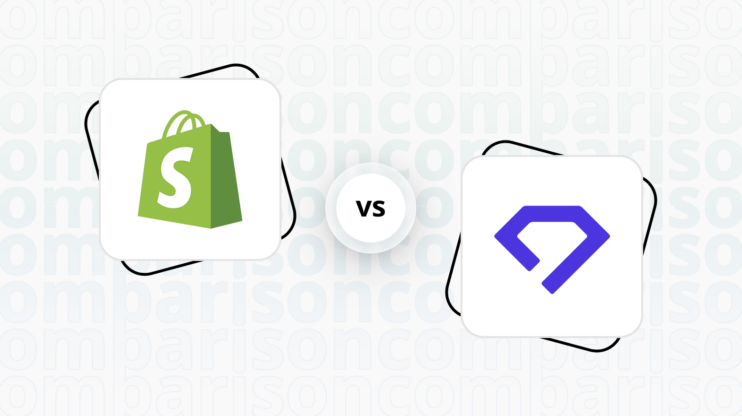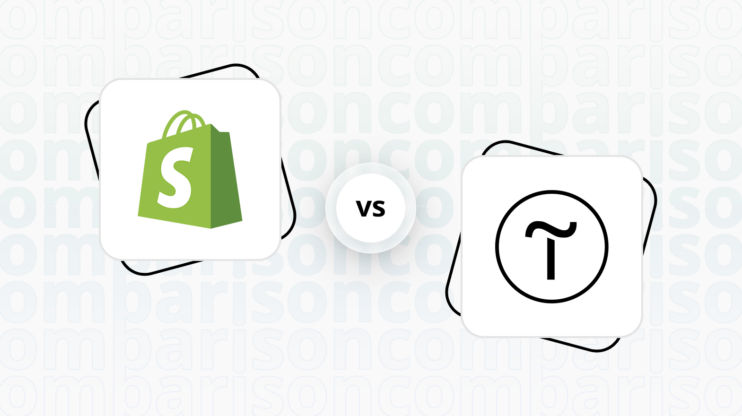Google Sites vs Instapage: Final verdict
Google Sites and Instapage both offer unique advantages, but they cater to different user needs and preferences.
-
Google Sites (Overall Grade: 5.6/10)
is ideal for users seeking a simple, collaborative website builder with seamless integration with Google services. It is particularly well-suited for team projects, personal portfolios, and small business websites. While it lacks advanced design customization and ecommerce features, its ease of use and affordability make it a practical choice for basic web presence needs. -
Instapage (Overall Grade: 6.6/10)
excels in creating high-converting landing pages with extensive customization options and advanced marketing tools. It is designed for users focused on improving advertising conversion through personalization, optimization, and testing. Instapage’s robust integration capabilities and user-friendly interface make it a powerful platform for marketing campaigns, although it comes with a higher price tag compared to Google Sites.

|

|
|
|---|---|---|
|
Design functionalities & templates |
4.9 |
8.0 |
|
Ease of use |
8.3 |
8.5 |
|
Ecommerce |
1.8 |
4.2 |
|
Website Editors |
7.0 |
7.5 |
|
Product testing options |
6.9 |
6.1 |
|
Price |
8.1 |
7.0 |
|
Hosting quality |
8.2 |
6.0 |
|
Website speed optimization |
3.3 |
6.2 |
|
Plugins and integrations |
6.4 |
6.8 |
|
Marketing features |
2.6 |
7.7 |
|
Customer support |
7.2 |
7.6 |
|
Security |
9.3 |
8.4 |
|
AI capabilities |
0 |
6.0 |
|
User Management |
7.8 |
7.3 |
Which one is the best for ecommerce: Google Sites or Instapage?
 1.8
1.8
 4.2
4.2
Verdict
: Google Sites and Instapage are not primarily designed for ecommerce, but Instapage offers more robust integration options for online selling.
-
Google Sites
: Google Sites is more suited for simple websites and team projects. It lacks built-in ecommerce features but allows for basic integrations with third-party tools like PayPal or Stripe. This makes it a less ideal choice for businesses with significant ecommerce needs. Best For Ecommerce score: 1.8 -
Instapage
: Instapage excels in creating high-converting landing pages and offers better ecommerce integration options, such as Shopify and various payment gateways. While not a full-fledged ecommerce platform, it provides more flexibility for online selling compared to Google Sites. Best For Ecommerce score: 4.2
Which one is the best for informational and business websites?
 7.2
7.2
 7.9
7.9
Verdict
: When it comes to creating informational and business websites, Instapage slightly outperforms Google Sites. Instapage’s robust design functionalities, ease of use, and extensive customization options make it a strong contender for businesses looking to optimize their online presence. Google Sites, while user-friendly and well-integrated with Google services, may lack some advanced features desired by more experienced web developers.
-
Google Sites
: Google Sites is a structured web page-creation tool included in the Google Workspace package. It enables users to build websites easily without having to know how to code, using a drag-and-drop interface. Users can integrate various Google services, such as Google Drive, Maps, and Calendar, directly into their websites. It’s designed for collaboration, allowing multiple users to work on a site simultaneously, making it a popular choice for team projects, personal portfolios, and small business websites. However, its simplicity comes with limitations, such as a lack of advanced design customization options and limited third-party integrations. Score: 7.2 -
Instapage
: Instapage is a comprehensive landing page platform designed to improve advertising conversion through personalization, optimization, and testing. It offers a range of tools for creating, testing, and optimizing landing pages with a focus on increasing sales, leads, and customer satisfaction. The platform boasts features such as AI content generation, targeted messaging through personalized landing pages, data-backed insights for optimization, and seamless ad-to-landing-page experiences. Instapage is recognized for its ease of use, allowing for the creation of high-performing landing pages without the need for a developer, and it facilitates team collaboration with its intuitive, cloud-based features. Score: 7.9
Google Sites vs Instapage: Detailed comparison
Design functionalities & templates
Design FunctionalitiesRepresents how well each platform allows for creative design and customization of websites.Score Components:
- Template Variety (30%): Range and quality of design templates.
- Customization (30%): Flexibility and options for design alterations.
- User Interface (20%): Ease and intuitiveness of the design process.
- Responsiveness (10%): Adaptability to different devices and screen sizes.
- Innovation (10%): Unique design features and tools.
 4.9
4.9
 8.0
8.0
🏆
Winner: Instapage.
If you’re looking for a platform with extensive customization options and a wide array of design features, Instapage is the preferred choice.
Google Sites offers a limited number of templates (around 17) suitable for various purposes, from personal blogs to business websites, with both free and premium options available. These templates are designed for user engagement, simplicity, and functionality, allowing for customization to meet specific needs. However, compared to other website builders, Google Sites might offer less variety in templates and design customization options.
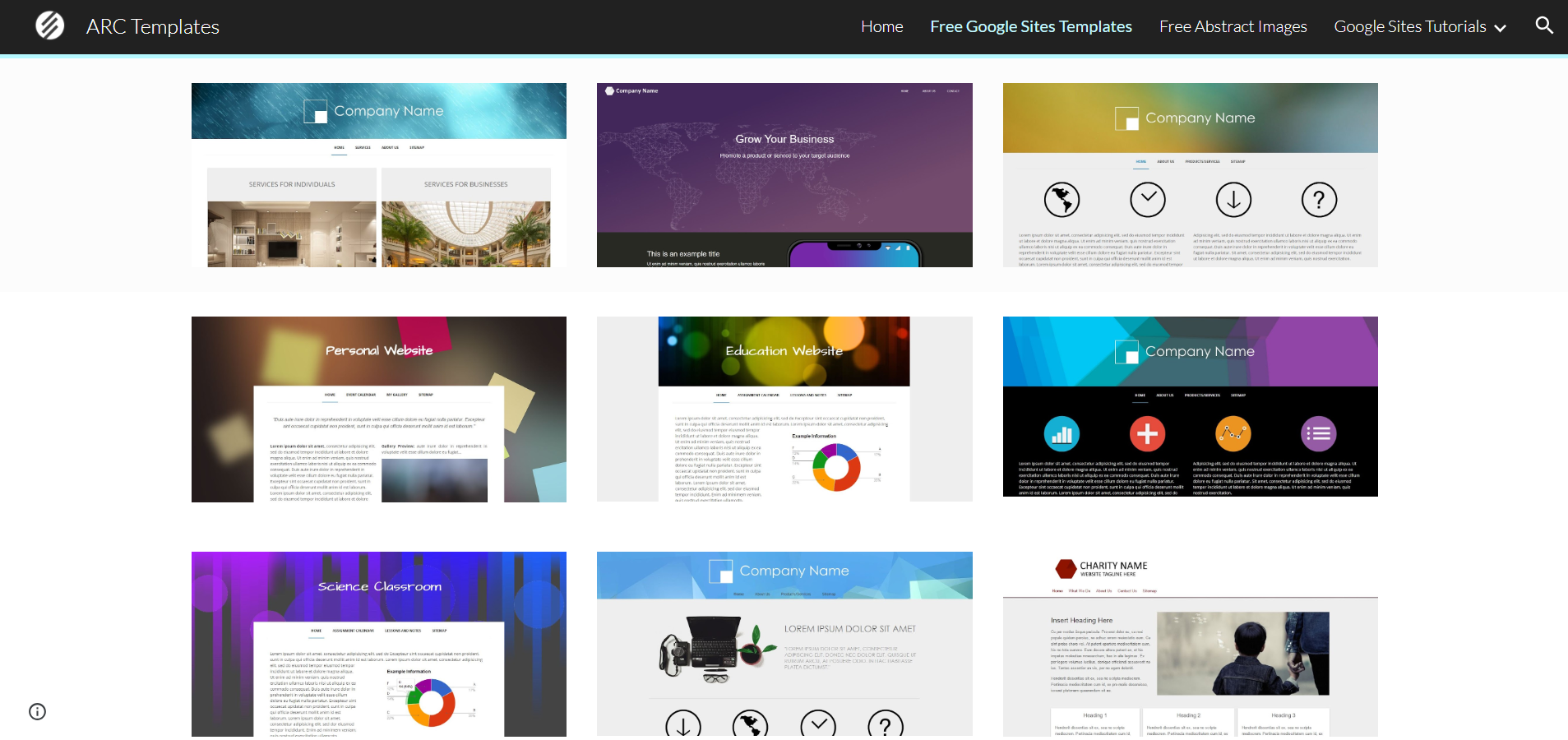

Instapage provides an extensive collection of 100+ design templates for website building, business-specific templates. These templates are tailored to support small teams and businesses in executing their marketing campaigns efficiently, including features for marketing automation, CRM, and analytics integrations.
Get a head start on website creation with AI
Create a custom website tailored to your business needs 10X faster with 10Web AI Website Builder!
Ease of use
Ease of useReflects the platform’s overall user-friendliness.Score
Components:
- Learning curve (40%): Quickness and ease of getting started.
- Interface design (30%): Simplicity and intuitiveness of layout.
- User guidance (20%): Quality of tutorials and support.
- Flexibility (10%): Adaptability to various user skills.
 8.3
8.3
 8.5
8.5
🏆 Winner: Instapage
. Scoring an 8.5, Instapage slightly edges out Google Sites, which scores 8.3. Instapage is recognized for its intuitive drag-and-drop interface and extensive customization options, making it accessible to users with varying levels of technical expertise. Google Sites also offers a user-friendly drag-and-drop interface and seamless integration with Google services, but it may lack some advanced features desired by more experienced web developers.
Learning Resources
🏆 Winner: Instapage
. Both platforms provide comprehensive learning resources, but Instapage’s extensive educational materials, including blogs, webinars, and a detailed Help Center, offer a more robust support system for users.
For ecommerce
EcommerceMeasures the platform’s effectiveness in supporting online business activities.Score Components:
- Ecommerce themes and templates (20%): Variety and design of templates.
- Product management (25%): Ease of managing and organizing products.
- Payment options (25%): Variety and convenience of payment methods.
- Ecommerce features (20%): Features for managing an ecommerce store.
- Integration (10%): Compatibility with external e-commerce tools and services.
 1.8
1.8
 4.2
4.2
Google Sites and Instapage are not primarily designed for ecommerce, but they can be adapted for online selling through third-party integrations. Google Sites is more suited for simple websites and team projects, while Instapage excels in creating high-converting landing pages.

|

|
|
|---|---|---|
|
Ecommerce themes and templates |
0.0 |
0.0 |
|
Product page customization |
0.0 |
0.0 |
|
Payment processing and commissions |
1.0 |
5.0 |
|
POS capabilities |
0.0 |
0.0 |
|
Payment gateways |
2.0 |
6.0 |
|
Product numbers |
0.0 |
0.0 |
|
Additional ecommerce features |
0.5 |
4.0 |
Google Sites ecommerce features:
- No built-in ecommerce features
- Can integrate third-party tools or widgets
- Embedding payment processors like PayPal or Stripe
Instapage ecommerce features:
- Shopify integration
- Payment gateways such as Stripe and PayPal
Ecommerce themes & templates
Neither Google Sites nor Instapage offers ecommerce-specific templates. Google Sites does not have any ecommerce templates, while Instapage focuses on landing pages without dedicated ecommerce templates.
Product page customization
Google Sites lacks any product page customization features. Products can be listed by embedding third-party platforms, and all customization must be done within those platforms. Instapage also does not have product page customization capabilities.
Payment processing
Google Sites allows for payment gateway integration using external tools or links, such as embedding HTML code for payment buttons from services like PayPal, Square, or Stripe. However, it does not offer comprehensive ecommerce capabilities.
Instapage supports payment gateway integration through external systems and third-party services like Commence Payments for Stripe, facilitating various payment options such as Apple Pay, Google Pay, and card payments. The platform itself does not directly charge commissions for transactions, but payment gateways may have their own fees.
In summary, while both platforms can be adapted for ecommerce, they are not ideal for businesses looking for robust ecommerce solutions. Google Sites is more suitable for simple websites with basic ecommerce needs, whereas Instapage is better for creating high-converting landing pages with some ecommerce integrations.
Website Editors
Website EditorsEvaluates the platforms’ website building and editing capabilities.Score Components:
- Customization tools (40%): Range and power of editing features.
- Editor usability (30%): User experience within the editor.
- Design flexibility (20%): Freedom in layout and design changes.
- Update and maintenance ease (10%): Simplicity of updating and maintaining the site.
 7.0
7.0
 7.5
7.5
🏆
Winner: Instapage
. Instapage, with a score of 7.5, offers a comprehensive website builder focused on creating and optimizing landing pages for various marketing campaigns. It features a drag-and-drop editor, AI content generation, detailed analytics, and extensive customization through custom code editing. Instapage supports collaboration, integrates with numerous marketing tools, and is designed to streamline the process of building, testing, and optimizing landing pages to increase conversions.
Google Sites, scoring 7.0, provides a user-friendly website builder editor that allows users to create and design websites without needing coding knowledge. With its drag-and-drop interface, users can easily add, customize, and arrange elements such as text, images, and videos on their web pages. Google Sites integrates seamlessly with other Google services, enabling the incorporation of Google Docs, Sheets, Slides, and Maps directly into the website. However, its simplicity comes with limitations, such as a lack of advanced design customization options and limited third-party integrations.
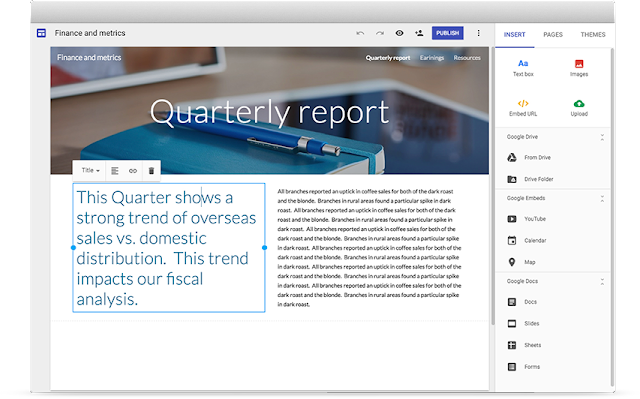
Mobile editor/app
 0
0
 0
0
🏆
Winner: None
. Both Google Sites and Instapage do not offer dedicated mobile editor apps. This absence means that users cannot make on-the-go adjustments to their websites or landing pages directly from a mobile device.
Google Sites is designed for simplicity and ease of use, making it accessible for beginners to create and publish websites without advanced technical skills. However, the lack of a mobile editor app limits its flexibility for users who need to make quick updates or edits while away from their desktops.
Instapage, on the other hand, focuses on creating and optimizing landing pages for marketing campaigns. While it offers a user-friendly interface and a range of features for desktop use, the absence of a mobile editor app can be a drawback for marketers who need to manage and optimize their landing pages on the go.
In summary, the lack of mobile editor apps for both Google Sites and Instapage means that users are restricted to desktop editing, which can be a significant limitation for those requiring mobile flexibility.
Product testing options
Product Testing OptionsAssesses the options for trying out platform features before commitment.Score Components:
- Trial quality (40%): Extent and usefulness of the trial or free version.
- Feature accessibility (30%): How many features are available to test.
- Trial duration (20%): Length of the trial period.
- Ease of transition (10%): Smoothness of moving from trial to paid plans.
 6.9
6.9
 6.1
6.1
Overall Result
:
Google Sites wins
. Google Sites scores 6.9, slightly higher than Instapage’s 6.1, due to its more accessible testing options. Google Sites offers a free version and a 14-day free trial, allowing users to test some premium features without any payment information. Instapage also provides a 14-day free trial but requires payment information upfront, which may lead to automatic charges if not canceled in time. Additionally, Instapage offers a 24-hour money-back guarantee, providing a brief window for refunds.

|

|
|
|---|---|---|
|
Free Plan |
Yes |
No |
|
Trial Duration |
14 days | 14 days (requires payment info) |
|
Testing Premium Features |
Some features during trial | During the free trial |
|
Money-back Guarantee |
No |
24-hour money-back guarantee |
Price
PriceLooks at the cost-effectiveness and value for money of each platform.Score Components:
- Plan value (40%): What each pricing tier offers.
- Transparency and clarity (30%): Clearness of pricing structures.
- Flexibility of plans (20%): Range of options to suit different budgets.
- Hidden costs (10%): Additional expenses not included in the plan.
 8.1
8.1
 7.0
7.0
Google Sites offers more affordable plans suitable for small to large businesses, while Instapage focuses on high-conversion landing pages with premium pricing.

|

|
|
|---|---|---|
|
$0-$10 |
Business Starter ($7.20/month): This plan includes basic features suitable for individuals or small businesses, offering professional email through Gmail, 30GB of storage per user, and video meetings for up to 100 participants. It allows to manage 1 website and there is no limitation on number of pages. Value for Price: 6.0 |
No offering at this amount. |
|
$10-$20 |
Business Standard ($14.40/month): Suitable for growing businesses, this plan provides 2 TB of storage per user, video meeting capacity for up to 150 participants with recording features, and access to smart booking pages and shared drives. It allows to manage 1 website and there is no limitation on number of pages. Value for Price: 7.5 |
No offering at this amount. |
|
$20-$30 |
Business Plus ($21.60/month): Designed for larger businesses needing more robust capabilities, offering 5 TB of storage per user, advanced security options, and video meetings for up to 500 participants. It allows to manage 1 website and there is no limitation on number of pages. Value for Price: 8.5 |
No offering at this amount. |
|
$200+ |
No offering at this amount. |
BUILD ($299/month): Optimize conversions with experimentation and lead generation. Includes #1 Landing page builder, No Conversion Limits, Server-Side A/B Testing, AI Content, Unlimited Triggered Popups, Thor Render Engine, Dynamic Text Replacement, SSL Encryption, GDPR Compliance, Google SSO, Zapier, HubSpot, Salesforce, Marketo Integration, Multi-Step Forms, Invisible reCAPTCHA, and more. Value for Price: 7.5 |
location. As a result in rare cases the prices displayed here can differ from the ones you see on their
websites.
Hosting quality
Hosting
qualityExamines the reliability and performance of the hosting solutions.Score Components:
- Uptime (40%): Consistency and reliability of website availability.
- Speed (30%): Loading times and performance.
- Bandwidth and storage (20%): Sufficiency of resources provided.
- Data centers (10%): Quality and distribution of hosting infrastructure.
 8.2
8.2
 6.0
6.0
🏆
Winner: Google Sites
. Google Sites provides a more reliable hosting solution with a 99.9% uptime guarantee and extensive global data centers. Instapage, while effective for landing pages, does not disclose its data center locations and has a lower hosting quality score.

|

|
|
|---|---|---|
|
Do they offer hosting? |
Yes, basic storage with 100MB free per site, upgradeable via Google Workspace |
Yes |
|
Data Centers: |
Google operates a total of 21 data centers across the globe: 2 in Asia, 5 in Europe, 13 in US and 1 in South America |
Instapage does not disclose the locations of its data centers |
|
Type of hosting: |
Cloud based managed hosting |
Cloud Hosting |
|
Uptime: |
99.9% |
99.9% |
|
Uptime Guarantee: |
Yes, 99.9% |
Yes, 99.9% |
Website Speed Optimization
Website Speed OptimizationEvaluates optimization of website loading timesScore Components:
- PageSpeed Score (30%): Google’s score indicating performance optimization.
- Loading Time (30%): The average time until a website is fully interactive.
- Mobile Optimization (15%): Optimization effectiveness for mobile devices.
- Resource Optimization (15%): Optimizing images, scripts, and other heavy resources.
- CDN Usage (10%): Use of CDN to enhance speed across geolocations.
 3.3
3.3
 6.2
6.2
🏆 Winner: Instapage
While both Google Sites and Instapage offer various strategies for optimizing website speed, Instapage has a higher overall score in this category.

|

|
|
|---|---|---|
|
Focus |
Automated Optimization, CDN, Mobile Optimization, Browser Caching, Code Minification, Use of AMP |
Responsive design, Image optimization, Caching |
|
Performance Tools |
Google PageSpeed Insights |
Google PageSpeed Insights |
|
Key Strategies |
Automated Optimization, CDN, Mobile Optimization, Browser Caching, Code Minification, Use of AMP |
Responsive design, Image optimization, Caching |
|
Load Times |
Google does not disclose statistics about website Page Speed scores, or load times. |
Load times and PageSpeed scores vary depending on optimization |
|
Page Speed Scores Range |
Not disclosed |
Varies |
|
Core Web Vitals Improvement |
Emphasis on LCP, FID, CLS improvements |
Not provided |
Google Sites employs a range of strategies for speed optimization, including automated optimization, CDN, mobile optimization, browser caching, code minification, and the use of AMP. However, Google does not disclose specific statistics about website Page Speed scores or load times, making it difficult to gauge the real-world performance of sites built on this platform. Google Sites does emphasize improvements in Core Web Vitals, focusing on metrics like Largest Contentful Paint (LCP), First Input Delay (FID), and Cumulative Layout Shift (CLS).
Instapage, on the other hand, focuses on responsive design, image optimization, and caching to enhance website speed. While specific load times and PageSpeed scores vary depending on the level of optimization, Instapage generally provides a more transparent view of its performance metrics. Although Instapage does not provide detailed information on Core Web Vitals improvements, its higher overall score in website speed optimization suggests a more effective approach to enhancing site performance.
In conclusion, Instapage outperforms Google Sites in terms of website speed optimization, making it a better choice for users who prioritize fast-loading pages and efficient performance.
Get a head start on website creation with AI
Create a custom website tailored to your business needs 10X faster with 10Web AI Website Builder!
Plugins and integrations
Plugins and integrationsMeasures the range and effectiveness of additional plugins and integrations.Score Components:
- Variety of options (40%): Range of available add-ons.
- Integration smoothness (30%): Ease of integrating plugins into the site.
- Quality of plugins (20%): Functionality and reliability of the options.
- Custom integration capabilities (10%): Support for custom or third-party integrations.
 6.4
6.4
 6.8
6.8
🏆 Winner: Instapage.
Instapage scores 6.8, slightly ahead of Google Sites’ 6.4, due to its robust integration capabilities tailored for marketing and conversion optimization. Instapage supports over 40 integrations with essential digital marketing tools, enhancing the overall marketing funnel and providing seamless ad-to-landing-page experiences.
Google Sites, while scoring 6.4, offers a wide array of plugins and extensions, particularly through platforms like Elfsight and Common Ninja, which enhance its basic functionalities with social media feeds, review displays, chat support, and e-commerce tools. These integrations make Google Sites a versatile choice for team projects, personal portfolios, and small business websites.
Both platforms provide valuable integrations, but Instapage’s focus on marketing and conversion gives it a slight edge in this comparison.

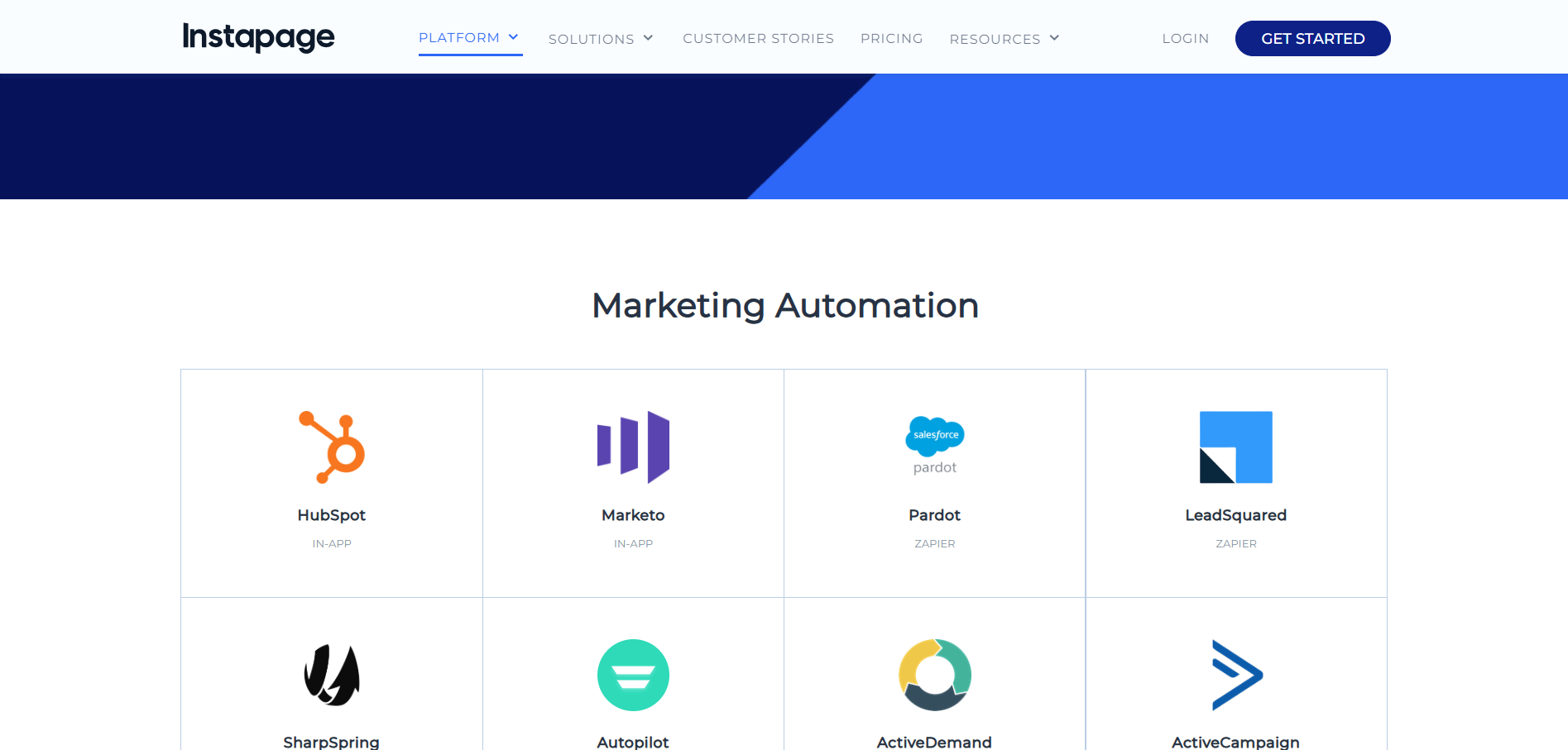
Marketing Features
Design FunctionalitiesRepresents how well each platform allows for creative design and customization of websites.Score Components:
- Template Variety (30%): Range and quality of design templates.
- Customization (30%): Flexibility and options for design alterations.
- User Interface (20%): Ease and intuitiveness of the design process.
- Responsiveness (10%): Adaptability to different devices and screen sizes.
- Innovation (10%): Unique design features and tools.
 2.6
2.6
 7.7
7.7
🏆
Overall Winner: Instapage
. Instapage excels with its advanced marketing tools, particularly in analytics, ad campaign management, and email marketing integration. Google Sites offers basic functionalities, making it more suitable for simple web presence needs.

|

|
|
|---|---|---|
|
SEO Tools |
Basic SEO settings |
✓ |
|
Email Marketing |
No |
✓ |
|
Blogging |
No | No |
|
Social Media Integration |
Basic integration through manual methods |
Advanced integration with tracking and ad platforms |
|
Analytics and Reporting |
Google Analytics integration |
Comprehensive analytics including A/B testing and heatmaps |
|
Ads and Promotions |
No |
Advanced ad campaign management and personalization |
Customer Support
Customer supportEvaluates the quality and availability of support options.Score Components:
- Response time (40%): Speed of support responses.
- Support quality (30%): Effectiveness and helpfulness of the support.
- Availability (20%): Range of support channels (phone, chat, email).
- Resource richness (10%): Quality of self-help and educational materials.
 7.2
7.2
 7.6
7.6
🏆 Winner: Instapage
. When comparing Google Sites vs Instapage, Instapage takes the lead in customer support with a score of 7.6. Instapage offers live chat support within the application from Monday to Friday, 24 hours a day, along with email and phone support during business hours. This ensures users have multiple channels to seek help and maintain a record of their service requests.
Google Sites, on the other hand, provides customer support primarily through self-service resources like a Help Center and community forums. Direct support, including phone, email, and live chat, is available to Google Workspace customers, with varying levels of support based on the subscription tier. While Google Sites offers 24/7 support for critical issues to eligible customers, free users have limited access to direct support, relying mostly on self-help resources.
For enterprise users, both platforms offer enhanced support options. Google Sites provides 24/7 customer support through phone and email for its enterprise plan, with the option to upgrade to premium support levels. Instapage’s Convert plan includes personalized assistance through Success Managers and Launch Specialists, ensuring a high level of dedicated support and guidance for optimizing conversion rates and maximizing ROI.
Security
SecurityLooks at the platforms’ security measures and data protection.Score Components:
- Data protection (40%): Safeguards for user and customer data.
- SSL and encryption (30%): Implementation of secure connections.
- Compliance (20%): Adherence to industry security standards.
- Regular updates (10%): Frequency of security updates and patches.
 9.3
9.3
 8.4
8.4
🏆
Winner: Google Sites
. Google Sites excels in security with a score of 9.3, leveraging Google’s robust infrastructure to provide SSL encryption, two-factor authentication, and automatic malware scanning. The platform benefits from regular security updates, DDoS protection, and compliance with international data protection standards, ensuring a secure environment for both website creators and visitors.
Instapage, with a security score of 8.4, also offers strong security measures, including SOC 2 Type I and Type II compliance, SSL/HTTPS support, and adherence to GDPR and CCPA regulations. Their Information Security Program is based on ISO 27001/2 and NIST 800-53 frameworks, covering various aspects of security from asset management to incident response. While Instapage provides comprehensive security for landing pages, Google Sites’ integration with Google’s extensive security infrastructure gives it an edge in overall protection.
AI Capabilities
AI capabilitiesMeasures the effectiveness of AI-driven features and tools.Score Components:
- Automation efficiency (40%): Impact of AI on streamlining processes.
- Personalization (30%): AI-driven customization for users or customers.
- AI-Assisted design (20%): Role of AI in website design and functionality.
- Data analysis (10%): Use of AI in interpreting user data and analytics.
 0
0
 6.0
6.0

|

|
|
|---|---|---|
|
AI Builder |
Google Sites does not have an AI website builder |
Instapage does not have an AI website builder |
|
AI Ecommerce Features |
Google Sites does not have AI ecommerce features |
Instapage does not have AI ecommerce features |
|
AI Content Generation |
Google Sites does not have AI content generation features |
AI Content Generator for headlines, texts, and CTAs |
|
Additional AI Features |
Google Sites does not have AI features |
AI Experiments for dynamic traffic allocation |
🏆 Winner: Instapage
. Instapage, with a score of 6.0, offers AI-driven tools that enhance the creation and optimization of landing pages. Its AI Content Generator helps in producing tailored content quickly, and AI Experiments facilitate efficient A/B testing by dynamically allocating traffic to higher-performing variants. These features make Instapage a more advanced option in terms of AI capabilities compared to Google Sites, which lacks any AI features.
User Management
User ManagementAssesses the platforms’ capabilities in managing user roles, permissions, and accessibility.Score Components:
- Role Customization (40%): Flexibility in creating and defining user roles and
permissions. - Ease of Management (30%): User interface and tools for managing users.
- Access Control (20%): Effectiveness of access control measures for different user
levels. - Scalability (10%): Ability to manage a growing number of users efficiently.
 7.8
7.8
 7.3
7.3
🏆 Winner: Google Sites
. Managing your online team with Google Sites and Instapage involves different approaches to website editing access.
- Google Sites allows multiple users to collaborate with different roles, including Owners, who have full control, and Editors, who can modify content but not site settings. There’s no strict limit on the number of users who can edit a site, allowing flexibility in management and development. Viewers can only see the site, with no editing permissions.
- Instapage users can be assigned different roles: Viewer, Editor, or Manager. A Viewer has limited access, only able to view pages. An Editor can edit pages, and a Manager has full access except for billing information and the audit log. The number of users you can invite depends on your subscription limits. However, only one user can edit a page at a time to prevent overwrite issues.
Both platforms support collaborative website building with varied levels of access and control for different users.
Instapage User Roles and Access Levels:
| Role | Description | Access Highlights |
|---|---|---|
| Administrator | Oversees the entire Instapage account, managing users, settings, and billing information. | Full access to all features, including user management, settings, billing, and page creation and editing. |
| Editor | Works on creating and editing landing pages, responsible for the design and content. | Can create and edit pages, manage integrations, and view analytics, but cannot change account settings or manage users. |
| Viewer | Has view-only access to the landing pages, typically for review or analytics purposes. | Can view pages and analytics but cannot make any edits or access account settings. |
Additional Features

|

|
|
|---|---|---|
|
SSL Certificate |
✓ |
✓ |
|
Custom Domain |
✓ |
✓ |
|
Free Custom Domain Included |
✓ |
X |
|
International Domains |
✓ |
✓ |
|
Mobile Responsive |
✓ |
✓ |
|
Page Speed |
✓ |
✓ |
|
Website Builder Mobile App |
X |
X |
|
Convert a Website To An App |
X |
X |
|
Website Analytics |
✓ |
✓ |
|
Multilingual Sites |
✓ |
✓ |
|
Multiple Users |
✓ |
✓ |
Google Sites vs Instapage: User Feedback
Users consistently praise Google Workspace, particularly Google Sites, for its seamless integration, ease of use, and collaborative features, making it a go-to solution for various professional and educational needs. The platform’s simplicity and user-friendly interface are lauded, enabling effortless website creation and sharing of information within organizations. While some users desire more customization options and additional features, overall, Google Workspace remains highly valued for its versatility and streamlined workflow facilitation.
Users generally appreciate Instapage for its user-friendly interface, robust customer support, and seamless integration capabilities, highlighting its effectiveness in creating high-quality, high-converting landing pages optimized for lead capture. Positive feedback emphasizes the platform’s ease of use, allowing both experienced marketers and newcomers to quickly design and deploy landing pages, along with its broad range of integrations with other marketing tools and CRM systems. However, some users encounter challenges with mobile responsiveness, custom domain settings, and occasional bugs.
The making of this blog
We followed a clear, step-by-step process to write and research this article.
Google Sites vs Instapage: FAQ
Which platform is better for creating landing pages, Google Sites or Instapage?
Can I integrate other marketing tools with Google Sites and Instapage?
How do Google Sites and Instapage compare in terms of user-friendliness?
What are the pricing options for Google Sites and Instapage?
Which platform offers better customer support?










